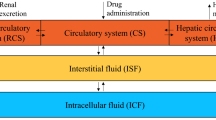Abstract
Purpose. The purpose of this study was to evaluate the effect of malignant effusions on the pharmacokinetics of methotrexate (MTX).
Methods. Simulated drug concentrations in blood, tissues and effusion fluid spaces were generated using a previously published physiologically based pharmacokinetic (PBPK) model for MTX in humans. The model was expanded to incorporate effusion spaces with permeability rate-limited drug transport. The model was used first to simulate MTX plasma concentrations in patients without effusions. Then the effects of cardiac, peritoneal and pleural effusions on MTX plasma concentrations were investigated followed by an examination of the influence of effusion volume, binding in the effusate, and effusion space permeability clearance (PA) on MTX plasma pharmacokinetics. In addition, the effect of the disposition characteristics (e.g. volume of distribution) of the anticancer drug on the overall influence of an effusate was evaluated. Finally, the simulations were compared with MTX concentrations observed in the plasma and pleural fluid of a patient with a pleural effusion treated with MTX.
Results. There was good agreement between the PBPK-simulated MTX plasma concentrations and observed values in patients without effusions. There was also a remarkable similarity between simulated and measured plasma and effusion MTX concentrations in a pediatric patient with a malignant pleural effusion. The physiological characteristics of an effusion, i.e. fluid volume, protein binding and membrane permeability clearance, modulate the influence of an effusion on the drug plasma concentration-time course. In general, effusions cause an increase in the steady-state volume of distribution but no change in the overall clearance of a drug. Malignant effusions were noticeable only in the disposition phase of MTX resulting in an apparent "third space." This was most prominent when the effusion fluid volume was large, the binding of MTX in the effusion fluid was greater than in plasma and the PA value was low. The percentage change in terminal half-life due to an effusion is significant for drugs with small volumes of distribution (332%) but not for those with large volumes of distribution (1.29%). In the case of MTX, and probably other anticancer drugs, the resulting increase in half-life may be associated with unanticipated toxicity.
Similar content being viewed by others
Author information
Authors and Affiliations
Additional information
Electronic Publication
Rights and permissions
About this article
Cite this article
Li, J., Gwilt, P. The effect of malignant effusions on methotrexate disposition. Cancer Chemother Pharmacol 50, 373–382 (2002). https://doi.org/10.1007/s00280-002-0512-9
Received:
Accepted:
Issue Date:
DOI: https://doi.org/10.1007/s00280-002-0512-9




